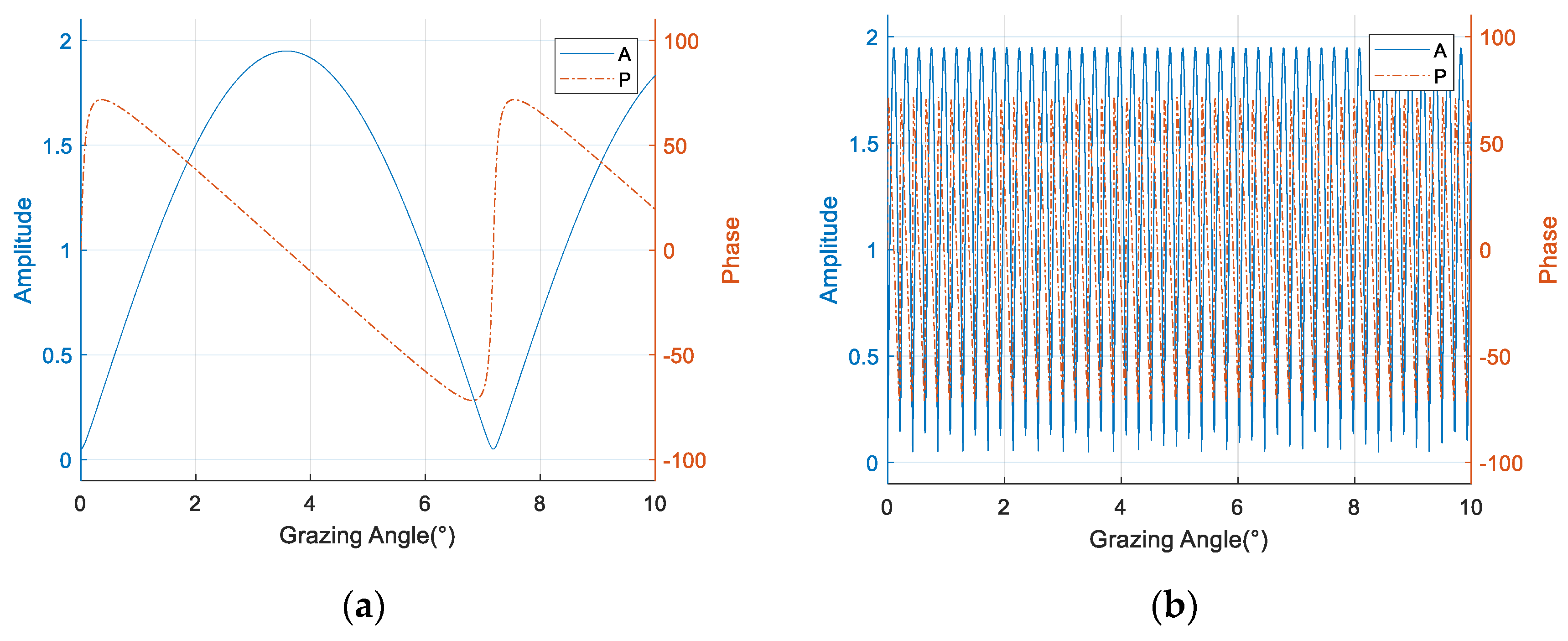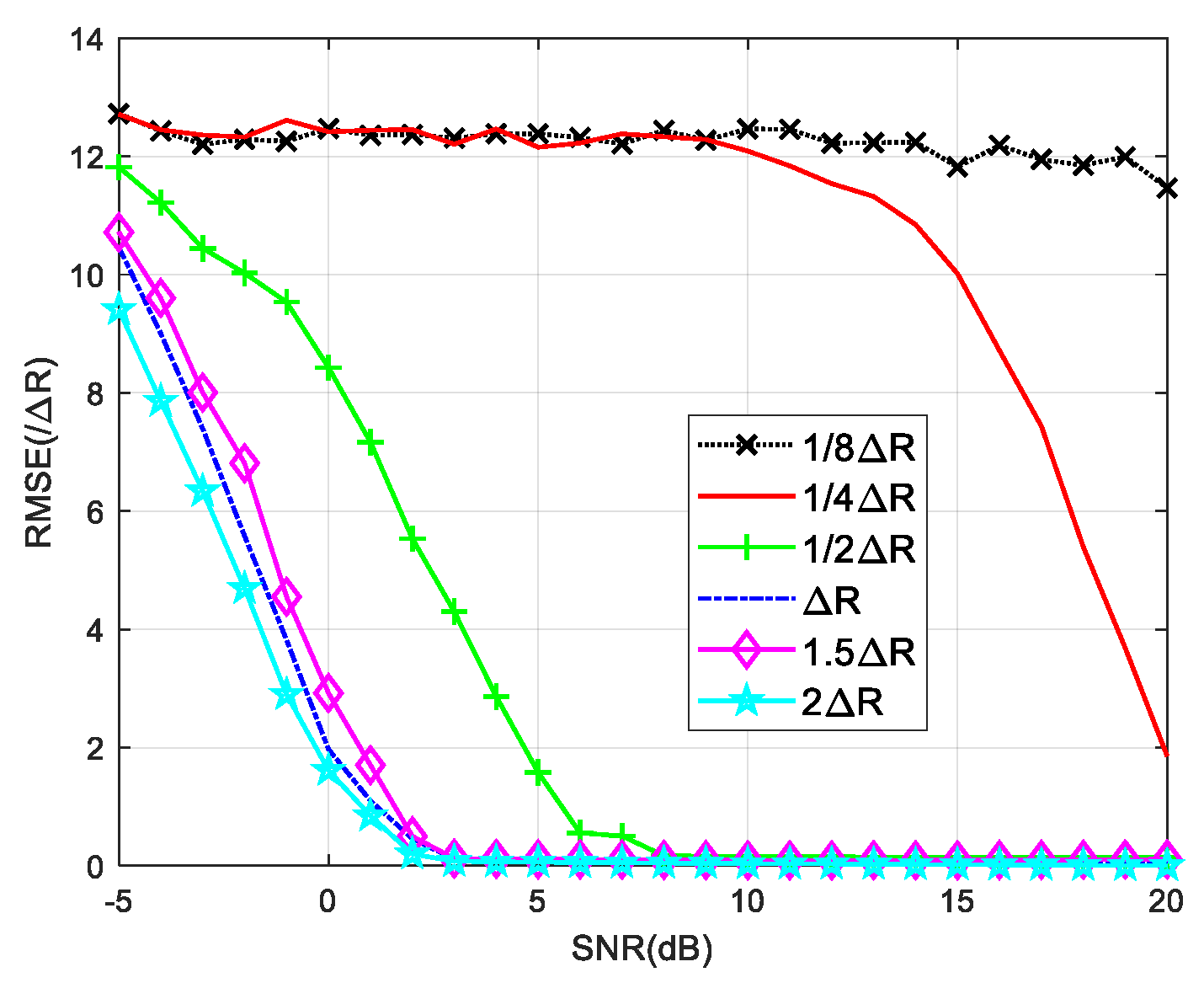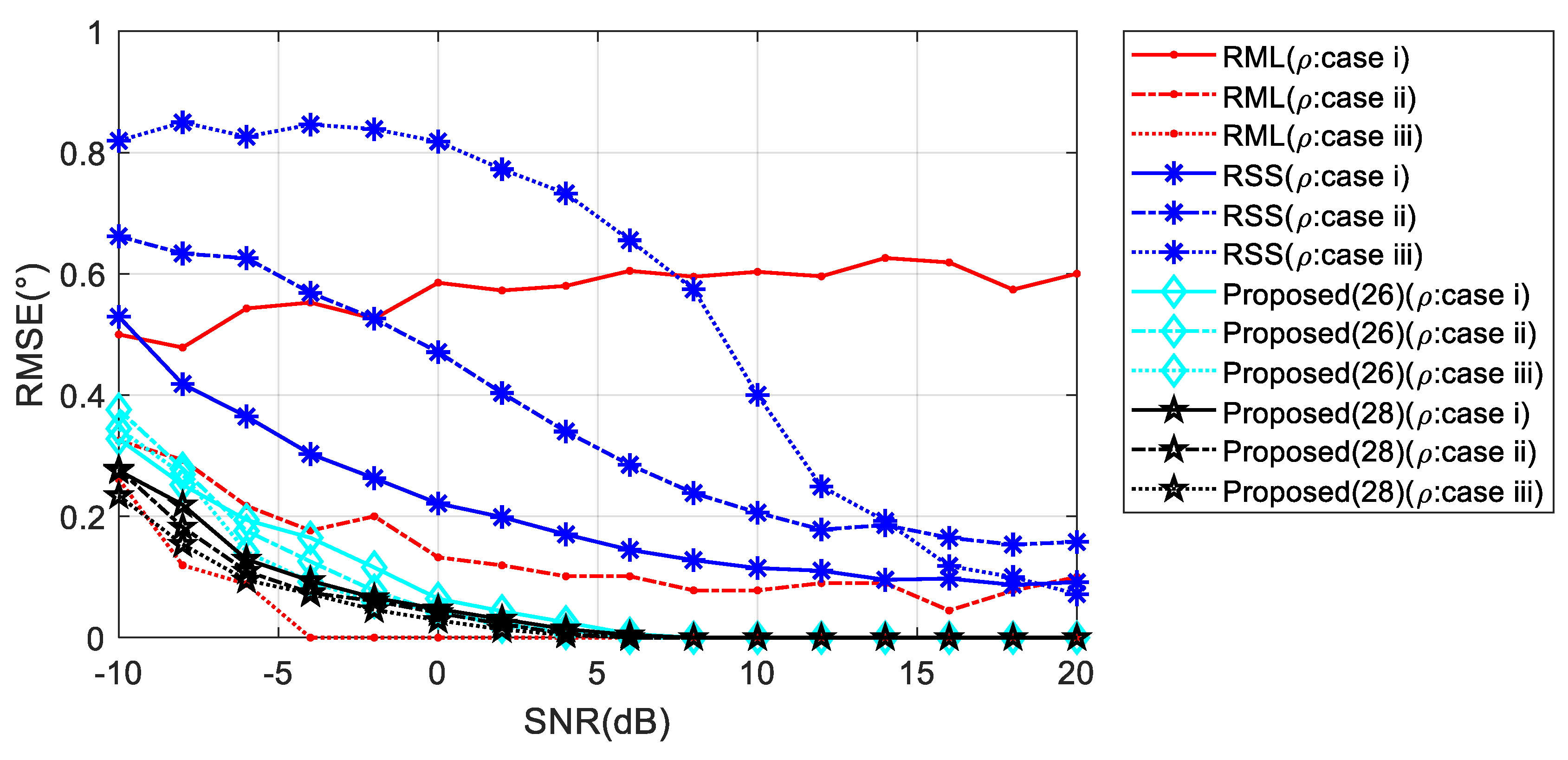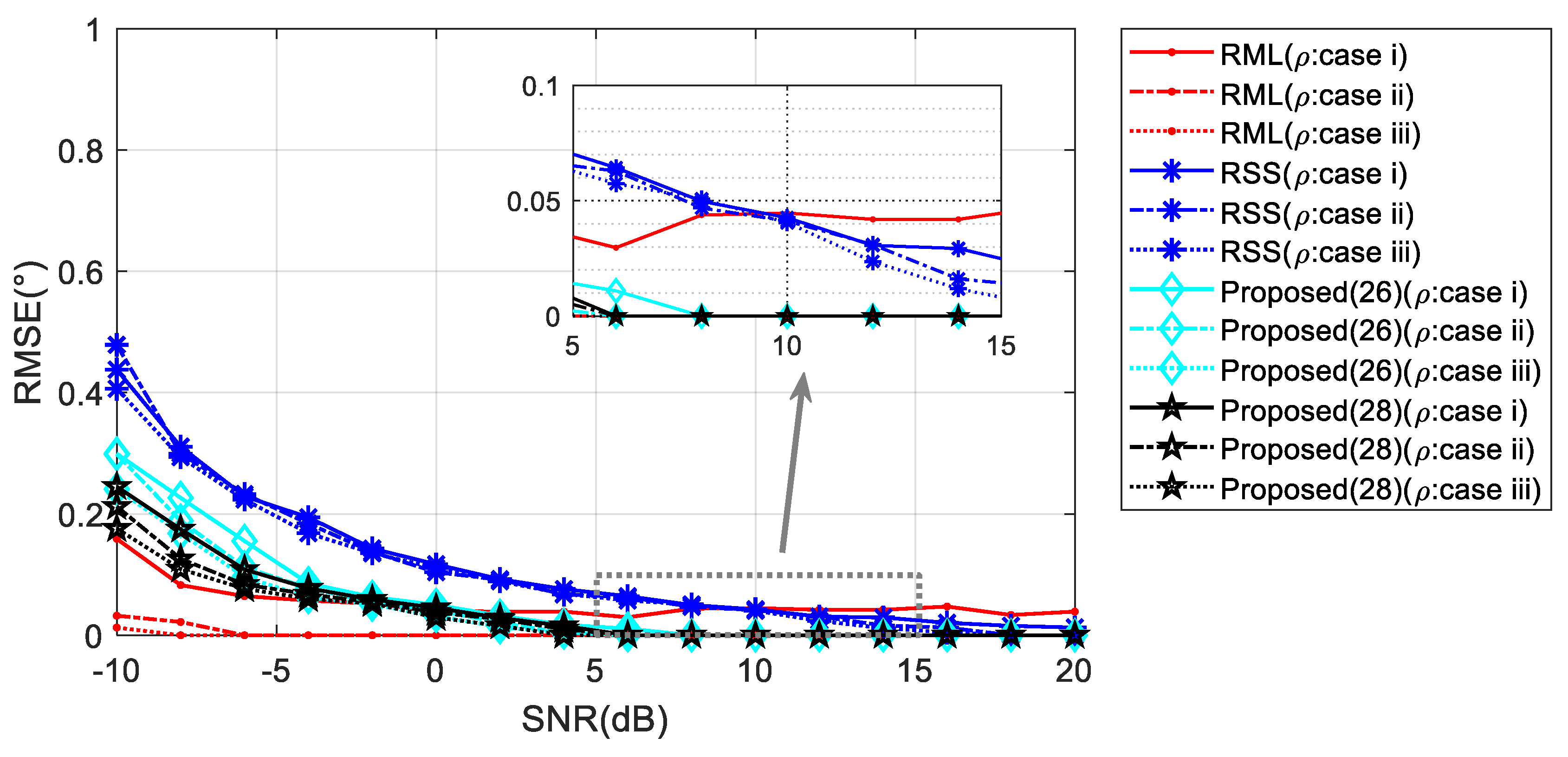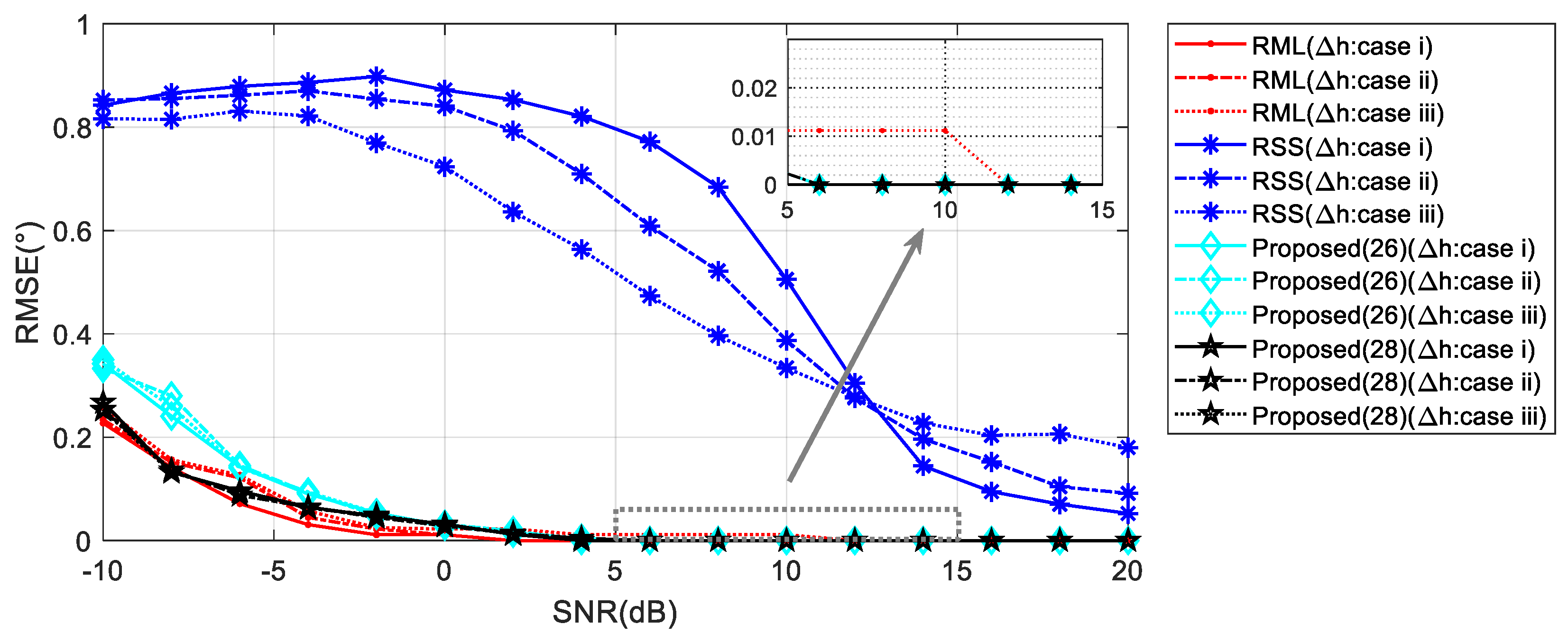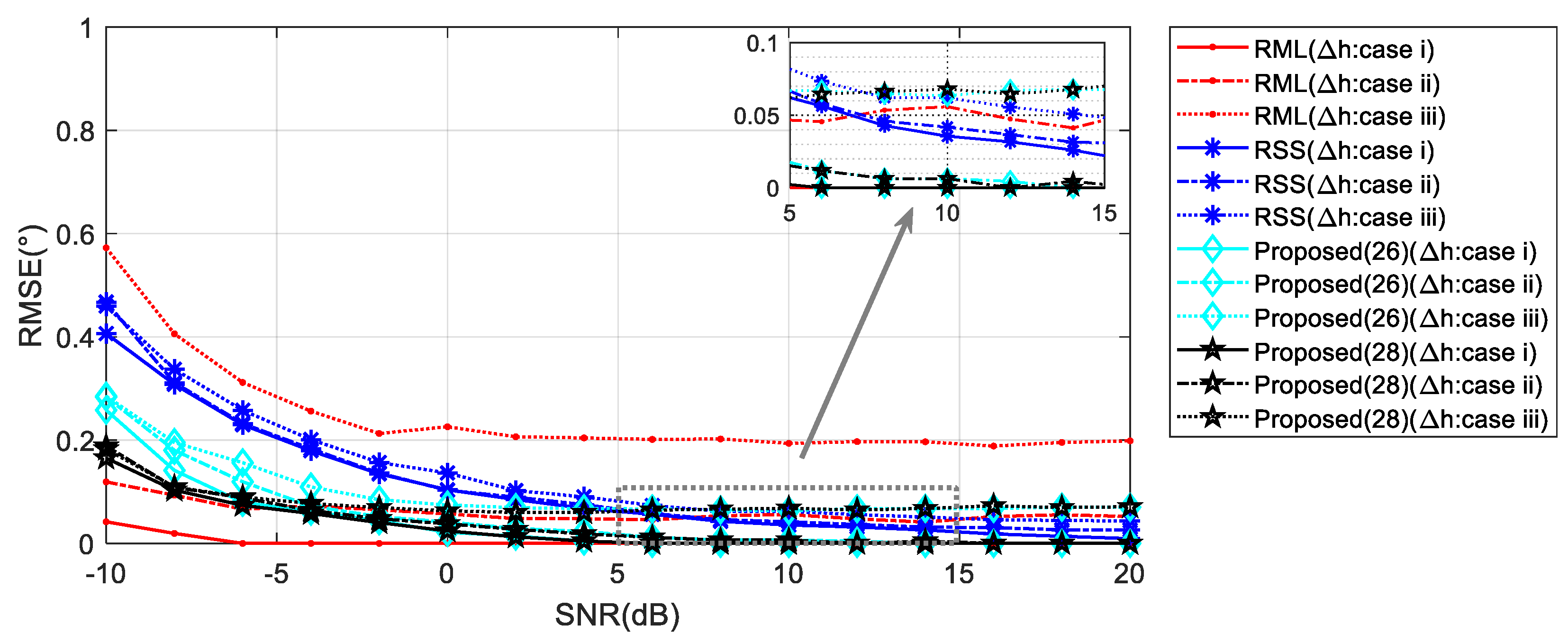1. Introduction
Low elevation radar tracking has become an urgent and important issue since the 1970s [
1,
2]. A considerable amount of research has been devoted to this complex multipath problem [
3,
4,
5]. The radar signal travels from target to radar in direct and indirect paths. The indirect paths consist of specular and diffuse components, where the former dominates in the case of a low grazing angle. It is difficult to perform angle estimation when the elevation of the target is so low that the angular separation between the direct signal and the specular reflection signal is less than 0.8 of an antenna beam width [
6]. Here, the conventional mono-pulse radar fails to perform tracking due to its weak capacity to cope with such closely spaced and correlated waveforms [
7].
Many methodologies have been developed for tracking low elevation targets based on array signal processing, and are mainly classified as subspace-based methods and maximum likelihood (ML) estimators. Subspace-based methods are also called non-parametric methods, such as multiple signal classification algorithm(MUSIC) and estimation of signal parameters via rotational invariant techniques (ESPRIT) [
8]. Generally, use of these methods can yield an angle resolution of less than one beam-width. However, the snapshots are usually inadequate for a full rank covariance matrix in radar applications. Meanwhile, the signal coherence may cause the covariance matrix to ill-condition. A spatial smoothing technique can be used to mitigate this problem [
9]. Unfortunately, this technique degrades the array gain and resolution and introduces biases to the estimates. On the other hand, a parametric model takes the height of the antenna, reflection coefficients and so on as a priori information, which works with a few snapshots and correlated sources. A refined maximum likelihood (RML) technique has been proposed based on a refined model [
10]. This model combines the geometric information and physical parameters, such as the refractivity gradient, the reflection coefficient, and the divergence factor [
11]. Using this a priori information contributes to good performance. However, in practice, the environmental parameters are difficult or even impossible to obtain. Vertical polarization, however, is usually not recommended as an alternative in low-angle estimation for its relatively fluctuating reflection coefficient both in amplitude and phase compared to horizontal polarization [
12]. Differences in surface coverage also perturb of the steering vector of the reflected wave. The uncertainty of the model leads to estimator failure, which is highly undesirable. Many approaches, including carrying out multiple iterations and approximations, have been proposed to solve this problem. Sparse Bayesian learning has been used to estimate the perturbation and elevation angle iteratively [
13,
14]. A robust maximum likelihood estimator involving the use of the minimax approach has been developed [
15]. Alternatively, the projection gradient method has been used to estimate jointly the reflecting surface height and target height [
16]. Two approximate maximum likelihood algorithms have been proposed for a joint estimation of the angle and Doppler in partially known additive noise [
17].
The methodologies mentioned above have improved the quality of the estimations to various extents. However, most of them suffer from being sensitive to the reflection coefficient, which needs to be estimated in advance. Moreover, there are not many works on broadband low elevation angle estimation. To achieve a suppression of grating lobes in low angle estimation, a noncoherent synthesis method is extracted from multiple frequency points [
18]. A frequency-agile algorithm using the RML model and involving adaptively adjusting the operating frequency during target tracking has also been developed. It can minimize the mean squared errors (MSEs) of the angle estimator [
19]. However, few of these works fully utilize the target information in the wideband multi-frequency signals.
In frequency diversity radar systems, the operating frequency is agile in a relatively wide frequency band, bringing about good detection and countermeasures performance. For wideband angle detection, the incoherent signal subspace method (ISSM) uses narrowband techniques on each frequency point, and finally combines the results incoherently [
20]. It is not an optimal solution since full usage of the coherent signals is not achieved. The coherent signal subspace method (CSSM) [
21] introduces a focusing step before estimating the covariance matrix at every frequency bin. Decoherence of the signal is achieved during focusing. Then, MUSIC is used on the entire focused narrowband covariance matrix. Both rotational signal subspace (RSS) [
22] and two-sided correlation transformation (TCT) [
23] are based on this focusing method, but they use two different ways to construct the focusing matrix. Several preliminary angle estimates of the target are needed to form the steering matrix for the focus.
The difference between the range of the direct wave and that of the reflected wave is determined geometrically from the target angle and the radar height, with this difference being small due to the low elevation angle. Since the use of wideband radar can provide a higher range resolution, a super-resolution algorithm was introduced here to further improve the range resolution. In this case, it became feasible to extract the angle information from the range difference. Many super-resolution methods have been used for image formation [
24], and with some of them, like Capon and the amplitude and phase estimator (APES) [
25,
26], the resolution levels are not significantly improved due to their nonparametric nature. RELAX [
27,
28,
29] was chosen in the current work as the super-resolution algorithm with an extended range resolution, which can not only recover the amplitude and phase of the signal in each element, but also effectively improve the performance for range estimation as an iterative optimization algorithm similar to the greedy algorithm.
In order to use wideband radar to track a low elevation angle target, we proposed using an angle estimation algorithm based on range super-resolution. The RELAX algorithm was used to further improve the range resolution for low elevation angle tracking. The energy of the direct wave and that of the reflected wave are separated in the distance dimension. Focus processing was performed on each of the two waves respectively. The algorithm obtained the angle values by synthesizing the steering vector of the direct wave and the range structure relationship between the two waves without any reflection parameter estimation. Thus, this algorithm was found to be more robust to various ground covers and more flexible for polarization waveform applications.
The rest of the paper is organized as follows. In
Section 2, the multipath propagation model is built. In
Section 3, the derivation of the multi-frequency refined maximum likelihood principle is described. Based on the sensitivity of the reflection coefficient, a robust angle estimator is proposed based on the range super-resolution for wideband radar systems. In
Section 4, we analyze the parameter selection and the performance of the algorithm, and in
Section 5, simulation results are presented to validate the proposed method.
2. Multipath Propagation Model
First, the multipath propagation models are discussed. The propagation of the electromagnetic wave between radar and target is two-way, and this means that four distinct paths occur from the transmitter antenna to the target and back to the array element. These four paths are composed of the transmitting multipath and the receiving multipath. For the phased array radar system, the impact of the transmitting multipath could be reduced by upturning the transmitting beam. The model in this paper only considers the one-way beacon propagation model [
1,
2] from the target to the radar to simplify analysis. Since the mechanisms of transmitting and receiving multipath are similar, the model and the algorithm proposed in this paper can be extended to the two-way propagation scenario. The geometries for the flat-Earth model and the curved-Earth model are illustrated in
Figure 1. The propagation medium was assumed to be linear, homogeneous, and isotropic within a wide frequency band. Meanwhile, the target location is at a great distance from the receiving antenna so that the direct and reflected signals can be considered as plane waves.
The reflected signals consist of the specular and the diffuse components. The specular component is highly correlated with the direct wave and is usually referred to as the coherent part of the reflected signal. The diffuse energy scattered from the irregular surface at random angles, which is the incoherent part of the reflected signal. When the reflection area is relatively smooth, like an ocean or lake surface with negligible wave disturbance, flat desert surfaces, and snow-covered terrains, the specular component dominates. Although the diffuse reflection is omitted in this paper, it will be added to the model in the next stage of research for complex terrain.
In the flat-Earth model shown in
Figure 1a, the echo of the target would reach each element along two paths. The reflection points of different array elements were distributed on the reflection plane, which is grid marked. Here, it is assumed that there is only one reflected path from the target for each array element. The diffuse component was treated as white Gaussian noise for simplicity. The width of the area was related to the array size and the target angle. For the relatively low grazing angles, the reflection point distribution area would be large. Such a result causes differences between the reflection coefficients corresponding to each element.
A uniform linear array (ULA) was applied in the current work, as shown in
Figure 1, which could be generalized to non-ULA models as well. Based on the assumptions above, in the flat-Earth model, the distance along the direct path between the
nth array element and the target may be calculated using the equation
where
is the target range information obtained using acquisition mode, and the array consists of
N sensors,
d is the distance between the two array elements, equaling to a half wavelength of the highest frequency in the bandwidth.
θD is the angle of incidence of the direct signal. The distance along the reflected path between the
th array element and the target is
where
θR is the incident angle of the reflected signal. Generally, the target is tens or hundreds of kilometers away, and the height of the radar is much smaller than that of the target. The approximation
can be made. The difference between these two paths was then derived, as shown in
Appendix A, to be
According to Equation (4), the path difference was determined from the array elements heights and the grazing angle.
In the curved-Earth model, the Earth can be replaced by the tangent plane of the reflection point. The difference between the two paths turns out to be:
where
RA and
RT represent the distances along the curve from the reflection point to the array and the target, respectively. They can be calculated iteratively by using Newton’s method [
18] to solve a cubic equation.
RE is the imaginary Earth radius, which can be calculated from the real Earth radius and the refractivity gradient, and
is the virtual height of the target relative to the tangent plane. The actual height can be calculated by Equation (5).
The discussion below was developed based on the flat-Earth model for simplicity.
5. Simulation
In this section, numerical simulations are executed to evaluate the proposed algorithm, demonstrating an improved robust performance in low elevation angle estimation.
We set simulation parameters for a typical wideband radar system in X band. A beacon model is applied in the simulation settings. All variables of the target state, the radar and the reflection area are parameterized. Different frequency points within the bandwidth are completely coherent.
The simulation parameters are listed in
Table 1.
Multi-frequency RML and RSS algorithms are applied here as comparisons. Both of them can complete the angle estimation from the wideband signal. In RML, the reflection coefficient used to build the model is a fixed value −0.95. In RSS, based on three points near the estimated value of each angle, a total of six points were selected as the estimated angles to construct the focus matrix.
5.1. Robustness of the Reflection Coefficient
First, we verify the robustness of the algorithms to the reflection coefficient ρ through simulations. We illustrate the global performance of the four algorithms in terms of the RMSE versus the SNR and the elevation angle θ in three cases. In the first and second cases, the reflection coefficient is −0.95 and 0.7, respectively. In the third case, the amplitude and phase of the reflection coefficient have random distribution errors within a certain range.
In the first case, when the signal parameters are completely consistent with the model parameters, the RML algorithm yields the smallest estimation errors for different SNR and
θ valuse. When the elevation angle is reduced to 1°, RML only needs the SNR of about −7 dB to complete the angle estimation, and shows an RMSE of less than 0.1°. For SNRs less than 0 dB, an accurate estimation can be achieved along the angle interval of 0.5–6°. Unlike other algorithms, RSS analyzes reflected and direct waves as two targets. In comparison, RSS is less capable of measuring closely targets. As shown in
Figure 7, the RSS yielded a significantly higher RMSE for an angle of 1° than for that of 5°. From
Figure 8, it could be concluded that when the SNR is 0 dB, RSS will not be able to distinguish between the direct wave and the reflected signal with an angle below 1.4°. At an SNR of 10 dB, this limit is 0.9°. Compared with the proposed Algorithms (26) and (28), the noise performance of Algorithm (28) is slightly better than the other one, and it is more obvious when the SNR is low. That is because the range estimation brings higher robustness. The (28) algorithm can obtain the RMSE accuracy which is less than 0.1° when the SNR is greater than −6 dB. Such angle estimation accuracy equivalent to RML can be achieved if SNR is higher than 8 dB, consistent with the analysis in
Section 4.1. Generally, the low elevation angle interval is defined as less than six degrees. With a sufficient SNR, Algorithm (28) can achieve accurate angle estimations for targets with elevation angles between 0.7 and 6°.
In the second case, both the amplitude and the phase of the reflection coefficient have fix error with the parameter
ρ in the RML model. The simulation results are shown in
Figure 9 and
Figure 10. RML is obviously deteriorated with an angular deviation, even for sufficiently high SNR. The calculation process of RSS does not utilize the reflection coefficient. In this case, the overall performance of RSS improves due to the reduced energy of the reflected wave located on the negative angle axis. As the reflected energy declines, its interference to the direct wave also decreased accordingly. Despite this, the low angle estimation performance of RSS is still non-ideal. Similarly, with a reduced reflected wave energy, the noise performance of the Algorithm (28) would be expected to slightly decline. Nevertheless, it performs better than several other algorithms.
In the third case, both the amplitude and the phase of the reflection coefficient have random errors between each array element. Three different degrees of random distribution of
ρ are listed in
Table 2.
Among them, in ρ:case i, the difference of the ρ distribution between the array elements is the largest, while for ρ: case iii, it is the smallest.
For low elevation angle, the phase difference between the array elements is small, and thus random distribution of
c has a greater effect on the phases of the reflected wave. It can be observed in
Figure 11, for
θ = 1°, as the variation range of
ρ rises, the RML and RSS performance decreases significantly. Meanwhile, Algorithm (28) exhibits stable performance.
When the elevation angle gets higher, the influence of the reflection coefficient on the phase of the reflected wave is expected to decrease. The performances of the comparison algorithms improve correspondingly. As seen in the inset of
Figure 12, RML performs best when the perturbation of
ρ is small. However, in the presence of a large perturbation, the algorithm corresponding to Equation (28) could provide the highest angle estimation accuracy.
5.2. Robustness of Reflection Surface Height
Fluctuations in height on the reflecting surface were concluded, from the analysis in
Section 4.3, to contribute errors to the estimated values produced by the proposed algorithm of the current work. Here, we also carry out simulation analysis of the presence of reflective surface height disturbances in the three cases.
Table 3 lists three cases of height fluctuations from small to large.
When the target elevation angle is relatively low, the perturbations on the range and element phases caused by the reflection surface height fluctuation are negligibly small. Therefore, in this case, the performances of the four algorithms does not change much. As shown in
Figure 13, in the presence of large disturbances, however, the proposed Algorithm (28) proves superior to RML due to the combination of the phase of the direct wave, which is not affected by the surface height.
As the target elevation angle rises, the distance errors and phase errors increase proportionally in
Figure 14. At this time, the RML has a poor performance when the disturbance is large. RSS has improved performance due to the increased angle. Algorithm (28) starts to appear in small errors depending on the level of the disturbance. When the reflection surface height fluctuation is 10 times the wavelength, the angle estimation accuracy is also less than 0.1°.
5.3. Bandwidth Performance
The bandwidth determines the range resolution of the radar system. As analyzed in
Section 4.1, the bandwidth determines the lower bound of the angle estimation based on the range super-resolution algorithm. The simulation of angle estimation capability under different bandwidth values is shown in
Figure 15.
We compare the performance of the proposed Algorithm (28) with different bandwidth values. Assume that the SNR is 10 dB and the reflection coefficients are a constant value −0.95. As shown in
Figure 15, to achieve the estimation angle RMSE less than 0.1°, the lower limit of the angle estimation is nearly 3° when the system bandwidth is 1 GHz, the angle lower limit rises above 4° when the bandwidth values decrease to 500 MHz. At a bandwidth of 2 Ghz, this limit is found to be around 1°. These results are consistent with the theoretical analysis in
Section 4.1.


